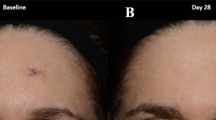Abstract
Background
In Asians, facial scars, even fine surgical scars, often can be conspicuous and uncomfortable. The authors used a topical silicone gel containing vitamin C on facial scars for the purpose of making the scar less distinct.
Methods
The study enrolled 80 patients. For the experimental group, the topical silicone gel mixture containing vitamin C was applied from the time of stitch removal to 6 months after the operation. The control group did not undergo any adjunctive treatment. Each participant was evaluated using the modified Vancouver Scar Scale (VSS) as well as erythema and melanin indices by spectrophotometer.
Results
With the modified VSS, the experimental group showed a significant decrease in scar elevation (p = 0.026) and erythema (p = 0.025). The hypo- or hyperpigmentation of the scars was more normalized in the experimental group. In the measured results via spectrophotometer, the experimental group showed a significant decrease in the melanin index (p = 0.045). The erythema index showed a statistically significant difference between the time of stitch removal and 6 months after the operation in the experiment group only.
Conclusions
Topical use of silicone gel containing vitamin C has the effect of improving the appearance of fine surgical scars in Asian facial skin.
Level of Evidence IV
This journal requires that authors assign a level of evidence to each article. For a full description of these Evidence-Based Medicine ratings, please refer to the Table of Contents or the online Instructions to Authors www.springer.com/00266.


Similar content being viewed by others
References
Chernoff WG, Cramer H, Huang SS (2007) The efficacy of topical silicone gel elastomers in the treatment of hypertrophic scars, keloid scars, and postlaser exfoliation erythema. Aesthet Plast Surg 31:495–500
Sproat JE, Dalcin A, Weitauer N et al (1992) Hypertrophic sternal scars: silicone gel sheet versus Kenalog injection treatment. Plast Reconstr Surg 90:988–992
Chan KY, Lau CL, Adeeb SM et al (2005) A randomized, placebo-controlled, double-blind, prospective clinical trial of silicone gel in prevention of hypertrophic scar development in median sternotomy wound. Plast Reconstr Surg 116:1013–1020
Perkins K, Davey RB, Wallis KA (1983) Silicone gel: a new treatment for burn scars and contractures. Burns 9:201–204
van der Wal MB, van Zuijlen P, van de Ven P et al (2010) Topical silicone gel versus placebo in promoting the maturation of burn scars: a randomized controlled trial. Plast Reconstr Surg 126:524–531
Sakuraba M, Takahashi N, Akahoshi T et al (2011) Use of silicone gel sheets for prevention of keloid scars after median sternotomy. Surg Today 41:496–499
Lee SM, Ngim CK, Chan YY et al (1996) A comparison of Sil-K and epiderm in scar management. Burns 22:483–487
Nikkonen MM, Pitkanen JM, Al Qattan MM (2001) Problems associated with the use of silicone gel sheeting for hypertrophic scars in the hot climate of Saudi Arabia. Burns 27:498–501
Vaxman F, Olender S, Lambert A et al (1996) Can the wound-healing process be improved by vitamin supplementation? Experimental study on humans. Eur Surg Res 28:306–314
Cabbabe EB, Korock SW (1986) Wound healing in vitamin C-deficient and nondeficient guinea pigs: a pilot study. Ann Plast Surg 17:330–334
Emamghorashi F, Owji SM, Motamedifar M (2011) Evaluation of effectiveness of vitamins C and E on prevention of renal scar due to pyelonephritis in rat. Adv Urol 2011:489–496
Yun IS, Lee WJ, Rah DK et al (2010) Skin color analysis using a spectrophotometer in Asians. Skin Res Technol 16:311–315
Rhee S, Koh S, Lee D et al (2010) Aesthetic effect of silicone gel on surgical scars in Asians. J Craniofac Surg 21:706–710
Spencer JM (2010) Case series: evaluation of a liquid silicone gel on scar appearance following excisional surgery: a pilot study. J Drugs Dermatol 9:856–858
Pladellorens J, Pintó A, Segura J et al (2008) A device for the color measurement and detection of spots on the skin. Skin Res Technol 14:65–70
Pershing LK, Tirumala VP, Nelson JL et al (2008) Reflectance spectrophotometer: the dermatologists’ sphygmomanometer for skin phototyping? J Invest Dermatol 128:1633–1640
Kim YS, Lew DH, Tark KC et al (2010) Effect of recombinant human epidermal growth factor against cutaneous scar formation in murine full-thickness wound healing. J Korean Med Sci 25:589–596
Khatri KA, Mahoney DL, McCartney MJ (2011) Laser scar revision: a review. J Cosmet Laser Ther 13:54–62
Aust MC, Knobloch K, Reimers K et al (2010) Percutaneous collagen induction therapy: an alternative treatment for burn scars. Burns 36:836–843
Kim E, Chang T, Hong J et al (2011) Use of tattooing to camouflage various scars. Aesthet Plast Surg 38:1–4
Kim SW, Han HH, Seo JW et al (2012) Two cases of lower body contouring with a spiral and vertical medial thigh lift. Arch Plast Surg 39:67–70
Conflict of interest
The authors declare that they have no conflict of interest.
Author information
Authors and Affiliations
Corresponding author
Rights and permissions
About this article
Cite this article
Yun, I.S., Yoo, HS., Kim, Y.O. et al. Improved Scar Appearance With Combined Use of Silicone Gel and Vitamin C for Asian Patients: A Comparative Case Series. Aesth Plast Surg 37, 1176–1181 (2013). https://doi.org/10.1007/s00266-013-0210-5
Received:
Accepted:
Published:
Issue Date:
DOI: https://doi.org/10.1007/s00266-013-0210-5




